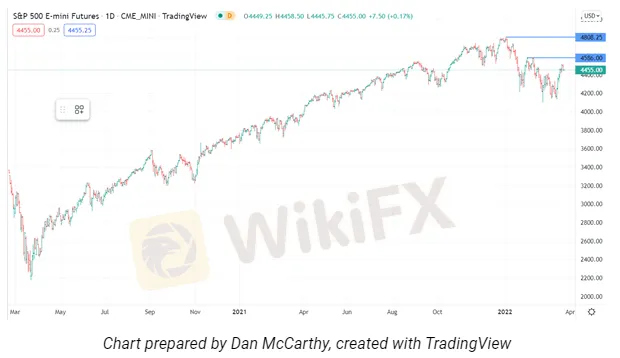简体中文
繁體中文
English
Pусский
日本語
ภาษาไทย
Tiếng Việt
Bahasa Indonesia
Español
हिन्दी
Filippiiniläinen
Français
Deutsch
Português
Türkçe
한국어
العربية
Short S&P 500: Top Trade Opportunities
Abstract:The S&P 500 has staged an extraordinary rally since stimulus measures were implemented in the wake of the outbreak of the Covid-19 pandemic in early 2020. At a time of a severe economic slowdown, the stock market has seen record highs. This is attributed to the fiscal and monetary policy responses.
It is well documented that the Federal Reserve has reversed its policy and is now beginning to tighten. The degree and velocity of which is up for debate, but it has been made clear that this is now the path of the central bank. The then-dovish members of the Federal Open Market Committee (FOMC) appear to have recognized that the need to fight inflation is now upon them.
The latest annual US data shows GDP growth at 7.0%, headline CPI at 7.9%, PPI at 10.0% and the unemployment rate under 4%.
Interest rate movements impact an equity valuation in many ways. Most pertinently, by the change in the cost of capital and the rate at which future cash flows are discounted. Companies that offer dividends also gain or lose on changes in rates as they become more, or less attractive investment alternatives.
Going into the end of the first quarter, the recent uptick in hawkishness from the Fed has seen equity prices rally, somewhat counterintuitively. The market appears to be looking at companies and believing that they will be able to pass on higher input costs. The higher that equity prices go under these assumptions, the further behind the curve the Fed falls.
In this scenario, the Fed could be forced to amplify its effort to rein in prices or alternatively, companies experience margin compression. The latter would seem less likely. Unless the prices of stocks fall, this feedback loop from equity markets may force the Feds hand for more aggressive tightening
S&P 500 DAILY CHART

Looking at the chart, the all-time high is at 4808 and a move above there could signal that further upside is possible. A failure to make a new high may see a bear market unfold in the medium-term.
The recent high of 4586 may offer resistance.

Disclaimer:
The views in this article only represent the author's personal views, and do not constitute investment advice on this platform. This platform does not guarantee the accuracy, completeness and timeliness of the information in the article, and will not be liable for any loss caused by the use of or reliance on the information in the article.
Read more

Webull and Others Fined $275,000 for Incomplete Suspicious Activity Reports
Webull Financial, alongside Lightspeed Financial Services Group and Paulson Investment Company, LLC, has agreed to pay a collective fine of $275,000 following an investigation by the US Securities and Exchange Commission (SEC). The penalty was issued due to the firms’ failure to include essential information in suspicious activity reports (SARs) over a four-year period.

Barclays Resolves £40M Fine Over 2008 Fundraising Disclosure Failures
Barclays has reached a settlement with the UK’s Financial Conduct Authority (FCA), agreeing to pay a £40 million fine for failing to adequately disclose arrangements with Qatari investors during its critical fundraising efforts amidst the 2008 financial crisis.

WikiEXPO Global Expert Interview: Advanced Practices and Insights in Financial Regulation
In the midst of rapid advancements and evolving landscapes in financial technology, financial regulation, and ensuring financial security, WikiGlobal stands at the forefront, closely tracking these transformative trends. As we embark on our series of exclusive interviews focusing on these pivotal areas, we are delighted to have had an in-depth conversation with.

Alleged Concerns with TradeEU.global's Trading Practices
An individual trader has come forward with allegations of an unfavourable experience while using the services of the broker TradeEU.global.
WikiFX Broker
Latest News
Saxo & Portuguese Bank Partnership
SEC Fines Broker-Dealers $275K for Incomplete SAR Filings
Elon Musk Warns of Imminent US Bankruptcy | Bitcoin Retreats from $100K
UK FCA Fines Barclays £40 Million Over 2008 Deal
WikiEXPO Global Expert Interview: Advanced Practices and Insights in Financial Regulation
Justin Sun Invests $30M in Trump-Backed World Liberty Financial
Lured by False Promises: Malaysian Driver Lost RM218K to an Investment Scam
FTX Sets March 2025 Timeline for Creditor Payouts: What It Means for Investors
What is an Economic Calendar? How it works
Pros & Cons of Automated Forex Trading
Currency Calculator


